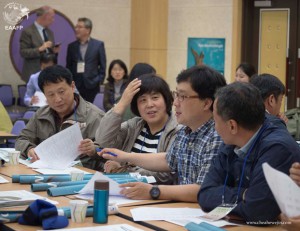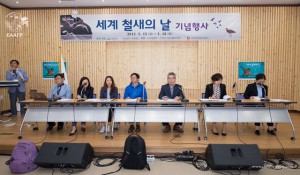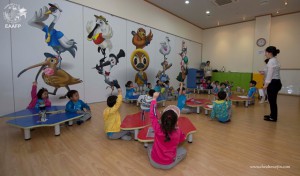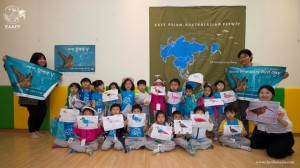Minseon Kim, EAAFP Programme Officer
To mark 2015 World Migratory Bird Day in Republic of Korea, a Flyway Site Manager workshop was organized on 15th-16th May 2015 by the Ministry of Environment of Korea, in cooperation with EAAFP, Seosan City and the National Institute of Biological Resources. At the opening ceremony, Young-In Kim, Vice Mayor of Seosan City delivered a welcoming speech followed by congratulatory speeches by Spike Millington, Chief Executive of EAAFP and Jong-Yoon Kim, General Director of Geum River Basin Environmental Office.
During the workshop, participants shared information and enhanced knowledge on migratory waterbirds and their habitats, shared and discussed challenges the site managers face, how these can be addressed and what resulting best practices are. Discussions were very animated and informative.
One key issue was lack of understanding and public awareness on the relationship between migratory waterbirds and Avian Influenza outbreaks. AI outbreaks are often linked to migratory waterbirds by some authorities, so the public and especially farmers are led to believe that migratory waterbirds are the cause of all AI outbreaks and damage to poultry farms. Since outbreaks are caused primarily by poor biosecurity and adverse conditions in poultry farms, people need to understand the migratory waterbirds are also victims of AI and the measures to control AI should be focused on improved management of farms and transport systems. This message needs to be promoted among farmers and authorities.
Another issue discussed was ongoing habitat loss especially in coastal wetlands including estuaries. Most site managers noted that local governments are bombarded with proposals of development from central governments and private companies. This calls for urgent measures to protect habitats, since local politicians and local people seek immediate, short-term economic benefits, which may be at the expense of the national, long-term public good. When this was brought up, there was more discussion on ecotourism (nature-based tourism) and migratory waterbirds. Discussion was very beneficial to all of participants.
Before closing, the collaboration between Ministry of Environment and Ministry of Ocean and Fisheries was highly appreciated by participants, since this kind of cooperation is unusual. This was very encouraging to all of them.
In total, around 80 people participated, including Ministry of Ocean and Fisheries, Korea Waterbird Network, Korea Shorebird Network, Ramsar Regional Centre for East Asia and BirdLife International.
As a side event, EAAFP Secretariat and Seosan Bird Land organised an environmental education program for 20 local nursery school kids to provide opportunities to learn about migratory waterbirds and the importance of Seosan as their habitat. The local students first coloured pictures of Bar-tailed Godwit and Baikal Teal while learning about their epic journey from EAAFP staff, and then went to see migratory waterbirds treated at the Wild Animal Rehabilitation Center under the supervision of rehabilitator, Mr. Kim Tae-Hoon. In addition, they watched a 4D film titled ‘Fly, Watercock!’ about watercock migration and the importance of Cheonsu Bay as breeding site.








